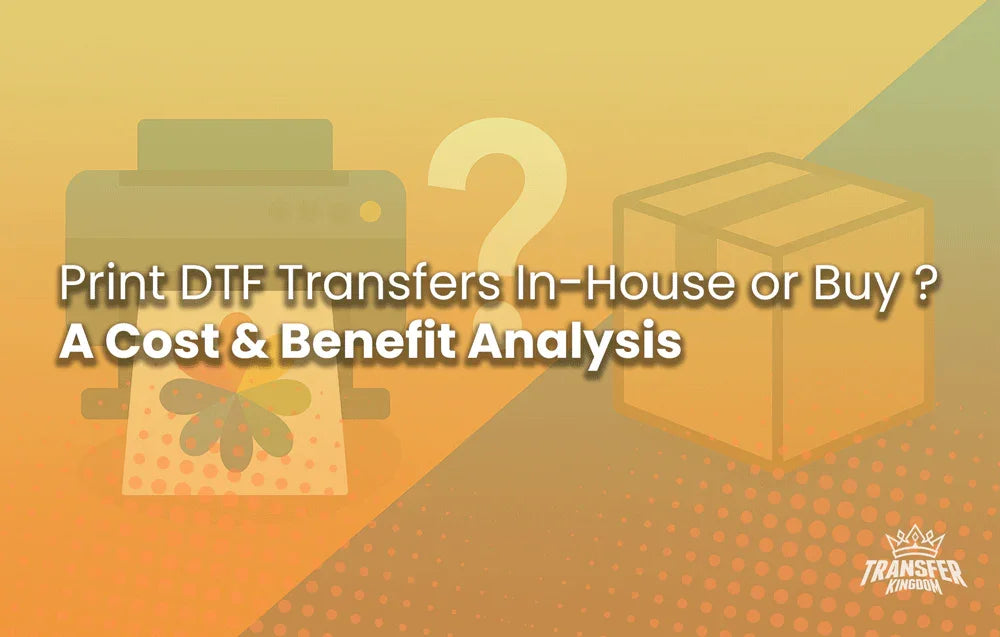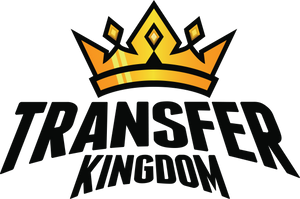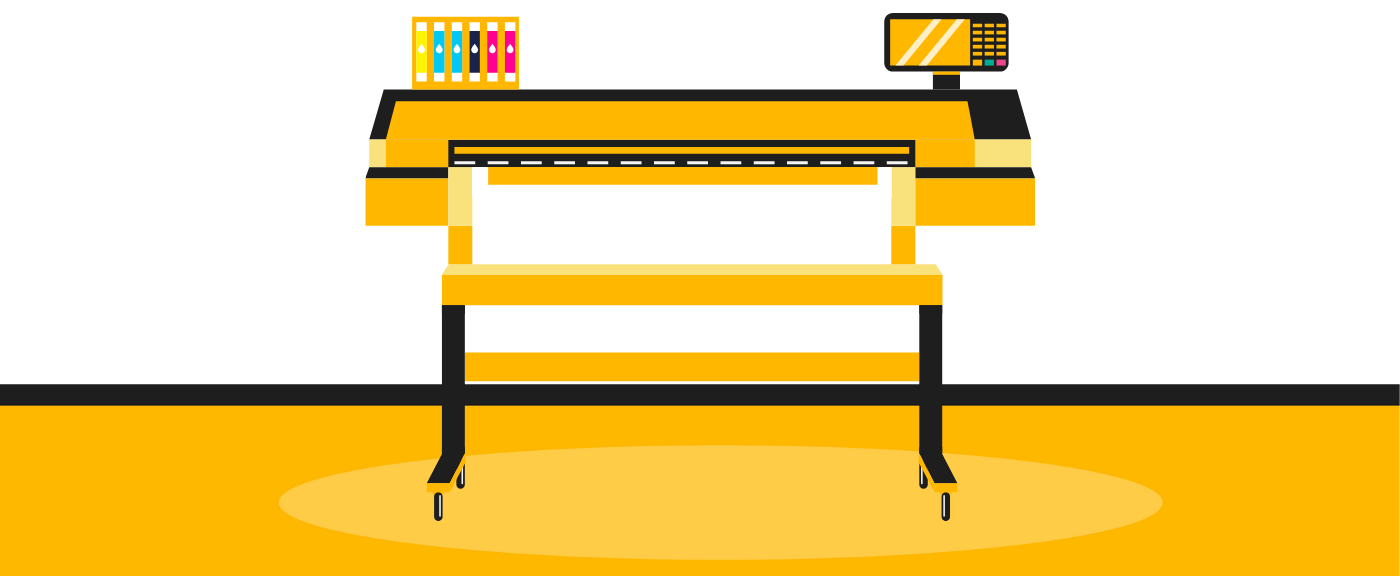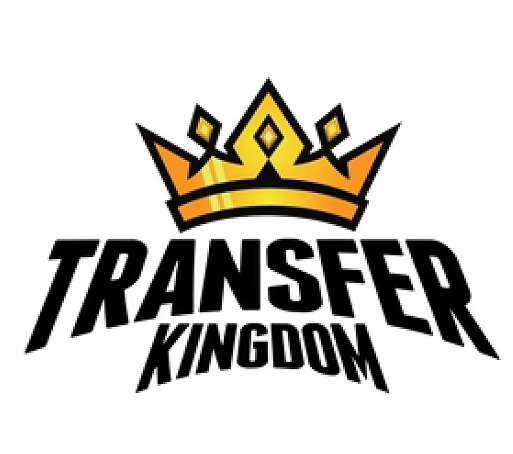Print DTF Transfers In-House or Buy? A 2025 Cost & Benefit Analysis

Table to Contents

Print DTF Transfers In-House or Buy? The Definitive Guide
For any entrepreneur in the custom apparel space, the Direct-to-Film (DTF) process presents a pivotal decision that shapes the future of their business: should you invest in the equipment to print DTF transfers in-house or buy them from a dedicated supplier?
This isn't just a question of cost; it's a strategic choice about where you want to invest your most valuable resources: your time, your money, and your focus. One path leads to becoming a print manufacturer, with all the technical challenges that entail. The other allows you to focus purely on design and growth, leveraging the expertise of professionals. This guide will provide a transparent, head-to-head comparison to help you determine which path is the right one for your brand.
The Case for Printing DTF Transfers In-House
The idea of having a DTF printer in your own workshop is appealing. It promises total control and the ability to print on demand. Let's look at the reality.
The PROS:
Total Control Over Quality: You have the final say on color profiles, ink saturation, and the quality of every single print.
Potentially Lower Per-Print Cost (at High Volume): Once you've paid off the initial investment, the material cost for a single transfer is lower than the price of buying one.
On-Demand Printing: Need a single print for a last-minute order? You can print it immediately without waiting for shipping.
The CONS (The Hidden Realities):
Massive Upfront Investment: The real cost to start a DTF business with an in-house setup is substantial, often ranging from $5,000 to over $30,000 for reliable equipment.
You Are the Technician: This is the most significant drawback. DTF printers require constant, daily maintenance, especially for the white ink channels. You will spend hours troubleshooting clogs, software errors, and mechanical failures.
Steep Learning Curve: Mastering RIP software, color management, and the nuances of the printing process takes significant time and results in a lot of wasted, expensive materials.
Hidden Costs: Your expenses don't stop at the printer. You have recurring costs for ink, film, powder, cleaning supplies, and replacement parts, not to mention the electricity bill.

The Case for Buying from a DTF Transfer Supplier
The alternative is to treat a DTF supplier, like Transfer Kingdom, as your production partner. You handle the creative and sales, and they handle the complex manufacturing.
The PROS:
Extremely Low Startup Cost: You don't need a printer, curing oven, or RIP software. Your only major investment is a quality heat press. This makes it the most accessible entry point into the custom apparel market.
Guaranteed Professional Quality: You get perfect, vibrant, and consistent transfers every time, printed on commercial-grade equipment that a home setup can't match.
Zero Maintenance Headaches: You never have to worry about a clogged printhead ruining your day or a software issue delaying an order. There are no technical challenges to overcome.
Focus on Growth: Your time is freed up to focus on what actually grows your business: creating new designs, marketing your products, and engaging with customers.
Scalability: Whether you need 10 transfers or 10,000, you can scale your production instantly without any new equipment investment.
The CONS:
Higher Per-Print Cost: The price of a single transfer is higher than the raw material cost of printing it yourself. However, this price includes the labor, expertise, and equipment cost you're not paying for.
Lead Times: You need to account for a few days for production and shipping, which requires slightly more planning than on-demand in-house printing.
Head-to-Head Comparison: In-House vs. Buying
| Factor | Printing In-House | Buying from a Supplier |
| Initial Cost | Very High ($5k - $30k+) | Very Low ($500 - $3k for a heat press) |
| Per-Transfer Cost | Low (Materials Only) | Higher (Includes service) |
| Time Investment | Extremely High (Printing & Maintenance) | Low (Ordering & Pressing) |
| Technical Skill | Expert Level Required | Beginner Friendly |
| Quality & Consistency | Variable, steep learning curve | Professional and Consistent |
| Scalability | Limited by your machine | Unlimited |
| Best For | High-volume, established print shops | Startups, designers, and growing brands |
The Verdict: Who Should Print In-House vs. Buy?
After analyzing the data, the decision of whether to print DTF transfers in-house or buy becomes clear when you define your business goals.
You should consider PRINTING IN-HOUSE if: You are an established, high-volume print shop already running other types of printing, have dedicated technical staff, and have the capital to invest in commercial-grade equipment and maintenance. For you, it's about adding another manufacturing capability.
You should BUY from a supplier if: You are a startup, a designer, an Etsy seller, a small business, or a growing brand. Your core business is creating and selling apparel, not maintaining complex printing equipment. The "Smart Startup" model of buying transfers offers a faster, cheaper, and safer path to profitability.
For the vast majority of entrepreneurs, buying transfers is the strategic choice. It minimizes risk, conserves capital, and allows you to leverage professional quality from day one. You can start your business today with just a heat press and your first batch of custom DTF transfers.

Frequently Asked Questions (FAQ)
Is it really cheaper to buy transfers?
For startups and small businesses, yes. The massive upfront cost and hidden maintenance expenses of an in-house setup far outweigh the per-print savings until you reach a very high, consistent volume.
How do I find a reliable DTF transfer supplier?
Look for a supplier with excellent reviews, fast turnaround times, high-quality materials, and great customer support, like Transfer Kingdom.
What if I have a rush order?
While in-house printing seems better for rush orders, a printer clog or malfunction can be catastrophic. A reliable supplier with a clear production schedule is often a safer bet for meeting deadlines.
Can I match the quality of a supplier with a DIY setup?
It is extremely difficult. Professional suppliers use commercial printers that cost tens of thousands of dollars and are calibrated for perfect consistency—something a converted desktop printer can't replicate.
At what point should I consider buying my own printer?
You should only consider it when your monthly spending on transfers is consistently so high that the monthly payment on a commercial-grade printer, plus all supplies and maintenance, would be lower. This is typically in the range of thousands of transfers per month.
What is the biggest benefit of buying transfers?
The biggest benefit is the elimination of risk and technical headaches. You get to run a creative business without the stress and expense of being a print technician.
Can I get different types of transfers from a supplier?
Yes. Professional suppliers often offer options you can't easily produce in-house, like glitter DTF transfers or other specialty films.
How do I get started if I buy transfers?
It's simple. You create your design, upload it to a gang sheet builder, place your order, and apply the transfers to your apparel with a heat press when they arrive.
Does buying transfers limit my creativity?
Not at all. It actually enhances it. By removing the technical barriers, you are free to experiment with any design, knowing it will be printed perfectly, allowing you to focus on creating the best custom apparel.
What's the smartest first step for a new apparel brand?
The smartest first step is to test your designs and market by ordering a small batch of transfers. This low-risk approach, detailed in our DTF business cost guide, proves your concept before you invest heavily.








